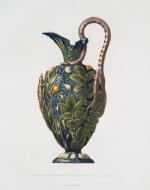Created by Kayla Moody on Tue, 02/18/2025 - 10:36
Description:
Majolica pottery stands as one of the most significant ceramic innovations of the nineteenth century, blending artistry with function in a striking display of color and craftsmanship. The Bard Graduate Center notes the introduction of majolica by Minton & Co. at the Great Exhibition of 1851, which quickly gained commercial success and widespread acclaim. Characterized by its 3D ornamentation and vibrant lead-based glazes, majolica became the pinnacle of Victorian decorative arts. Over the following decades, numerous English and American potteries produced majolica, ranging from grand exhibition pieces to everyday tableware, demonstrating the versatility and lasting charm of this ceramic creation.
Majolica was introduced to Italy in the 15th century by Moorish Spain via the island of Majorca, from which it takes its name. The tin-glazed Italian majolica took the world by storm. However, its trajectory changed in the 19th century when Léon Arnoux, a French-trained artist, was hired by Herbert Minton, the successor of Minton & Co., the leading pottery factory of the Victorian era. Arnoux mastered lead-glazed earthenware and made majolica into the richly colored sculptural style that it became. Among the most distinctive forms of majolica is Palissy ware, developed by Minton & Co. and named after the French Renaissance potter Bernard Palissy. First showcased at the 1851 Great Exhibition, Palissy ware featured vividly colored and highly detailed naturalistic designs, setting the stage for mass production throughout Europe and America.
Majolica's official unveiling at the 1851 Great Exhibition cemented its status as a Victorian artistic triumph. The display garnered both commercial success and critical acclaim with the Art Journal in 1856 praising Minton’s majolica as "one of the most successful revivals of modern pottery." Minton & Co. received a prestigious Council Medal for their "New Application & Beauty of Design," solidifying majolica’s place in the history of ceramic arts. Though its origins are cited in England, majolica was influenced by Italian Renaissance traditions, Moorish communities in Spain, and Persian ceramic artistry, sparking debates about its true lineage. Today, it remains a cherished art form, celebrated for its bold designs, rich colors, and intricate craftsmanship, all of which preserve the legacy of majolica as one of the most remarkable ceramic achievements of the nineteenth century.
Majolica Pottery Booth by Kayla Moody, 2025. This design takes on two dimensions to depict a hypothetical booth at the Great Exhibition of 1851 displaying the wonders of Majolica pottery. It features various wares ranging in time and origin to highlight the versatility and vibrance of majolica pottery. The collage includes red drapery and indoor greenery to depict the ornate and visually appealing atmosphere of the Great Exhibition.
Page from The Art Journal: Illustrated catalogue of the International Exhibition, 1862 London, 1863, Sp Coll BD3-b.25. Minton & Co. ceramics: The centered figure is a Parian (marble-esque porcelain) depiction of Prince Alfred with his Shetland pony, modelled by Baron Marochetti, an Italian-French sculptor. The featured Italian vase is Majolica, decorated from a design by Mr Alfred Stevens, a Belgian painter.
Urn by Aiguière, Collection d’Andrew Fountaine Esquire, Narford Hall, Angleterre, 1862. This photo print depicts an illustration of a French urn in the style of naturalistic Palissyware. It was issued in 1862 and depicts water, leaves, lizards, shells, and snakes. Commonly featuring an earth-toned palette and using naturalistic scenes of plants and animals cast from life, each component is typically modeled and painted individually. The Victoria and Albert Museum cites, “What is now known as majolica was a range of vibrantly coloured lead glazes launched in 1849 as Palissy ware. Only later did these become known as majolica ware."
Majolica Vase by Minton 1867. Minton showcased its wares at the Paris International Exhibition of 1867 and later at subsequent world's fairs, including the Centennial Exhibition of 1876, exhibiting pieces such as this illustrated majolica vase.
Thomas Kirby, Watercolor Illustration of First Majicola Design, G144. The Minton Archive believes this illustration to be inspired by historical wares. They claim it to be signed and also annotated by Minton artist Thomas Kirkby, who identifies it as being the first majolica design produced by Minton. Design G144 is identified simply as one of 3 Water Colour Drawing designs for round dishes.
Thomas Kirby, Watercolor Inscription of First Majicola Design, G144. The inscription reads, “This is the First Design for Majolica, that was made, and was also executed upon the first Majolica Dish painted and made at Mintons Manufactory.” The Minton Archive finds this inscription curious since the unique artwork is absent from future art catalogues.







